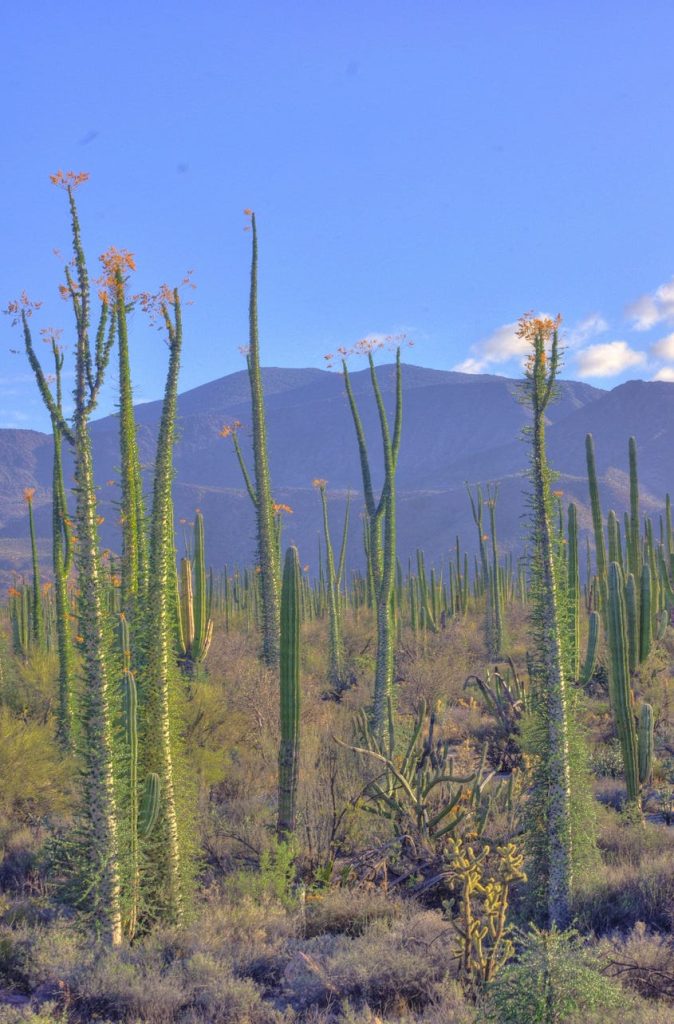by Alberto Búrquez
I remember watching the Sea of Cortez from the “Mancha Blanca”, a beach south of Desemboque the largest settlement of the Comcaac people in the coast of the Gulf of California. That happened when I was a child at the end of the 1950s. I remember each annual expedition as a voyage of discovery of new wonders along the mainland coast of the Gulf. I remember looking through a sea full of life towards Isla Patos and further to Isla Angel de la Guarda and the distant coast of Baja California. When I say a sea full of life, I mean it. Totoabas as large as a person, schools of hammerhead sharks that patrolled the rocky reefs, porpoises that gracefully broke the mirror of the early morning sea. I remember dreaming of the unknown treasures of the almost uninhabited land across the sea. Since then, I’ve been in Baja California many times. Each time, it has been a wonderful and revealing journey, full of fantastic landscapes, strange plants and especially wonderful people.

My most recent trip to Baja California (Americans, in their taste for abbreviations call it “Baja”) was with a friendly and pleasant company: my colleagues Dr. Souza and Dr. Eguiarte, my assistant Dr. Bustamante, and my young student Sebastian Arenas. We went looking for populations of the organ pipe cactus (Stenocereus thurberi); a widely distributed cacti of the Sonoran Desert. We intended measuring the variation of its populations in morphological, demographical and genetic terms.
Our journey began in Hermosillo, the state capital of Sonora. Driving along Highway 15 we headed to the coastal town of Topolobampo. There we boarded the ferry to go across the Gulf towards La Paz, Baja California Sur. Once on the mainland, we drove to Sierra La Laguna in the Cape Region. The Sierra is a mountain massif in the southern tip of the peninsula. In its lower part it contains isolated communities of tropical dry forest, while in the peaks, small forests of pine and oak dominate. The only pine species of the sierra is the endemic subspecies of Mexican pinion, Pinus cembroides subsp. lagunae. Near the Pacific Ocean, south of Todos Santos, we found populations of coastal pitayo (Stenocereus littoralis) a small columnar cactus closely related to the organ pipe cactus. It grows on the coast not far from the dense thornscrub of the Sierra La Laguna foothills.

Our expedition took us along the peninsula on a journey over 1500 km long. In the southern end, south of the Tropic of Cancer (23° S), we found beautiful forests of “palo blanco” (Lysiloma candida) trees with long slender white stems. As we traveled north, the contorted “copalquín” (Pachycormus discolor) trees started to appear standing against the red rocky ranges and deep azure skies. Near the 28th parallel, close to the dividing line between the two peninsular states (Baja California Sur and Baja California), the strange and tall “cirio/boojom trees” (Fouquieria columnaris) started to dominate the landscape, and finally above parallel 30 ° N, in the northernmost part of the trip, plant communities typical of Mediterranean climates made their first appearance. The “cardón” (more correctly called sagüeso—a type of cactus—Pachycereus pringlei) and the organ pipe cactus were always present along the journey.
In many places, we sampled local populations of the organ pipe cactus. On each individual we measured height and width, number of branches, length of the spines, number and size of the ribs—the accordion shaped folds characteristic of columnar cacti—were measured. We also took a sample of tissue to extract DNA and then compare their genetic similarity (or dissimilarity) with samples from other locations along the way. Our working hypothesis rests on the argument that peninsular populations closest to the region of the large islands of the Gulf of California (Isla Tiburón, Isla San Esteban, Isla Partida, etc.) are more similar to each other than more distant populations. The islands are stepping stones that allow the passage of plants and animals from the mainland to the peninsula (or vice versa). If diffusion of genes occurs, populations will be more and more different as the distance increases to the south or to the north of this region.

This possible differentiation between populations can occur because pollinators and seed dispersers—the lesser long-nosed bats (Leptonycteris yerbabuenae)—travel after a complex migration that leads from the mountains of the Sierra Madre to the desert plains, and then across the Gulf. The bats carry pollen and seeds directionally between populations leaving genetic patterns printed in what biologists call “gene flow”. The strength of gene flow allows us to reconstruct the evolutionary history of this species and the relatedness among populations—the genetic distance. The other possible scenario is that organ pipe cactus populations separated long time ago when the Gulf of California was created through tectonic processes, and since then both lineages were separated in a process known as vicariance. The search of geographical barriers and the morphological variation in our populations led us to lengthy and friendly discussions that we ended measuring not in clock time, but in car mileage and number of visited localities.

Wonderful things happened during our trip. We found extraordinary landscapes, and we witnessed marked transitions of vegetation types. We moved from organ pipe populations with a heavy load of lichens near the cold and windy shores of the Pacific Ocean, to populations in the dry and warm locations near the Sea of Cortez. The discovery and excitement of academic debate on the side of the road and the feeling of sublime nature in the unspoiled landscape were as important as the biological richness of the places we visited. These will provide material for a future account of our adventures and will form the basis of the results that will tell us about the story of genes of the organ pipe cactus catching a ride on the wings of the bat migration across the Gulf of California.




